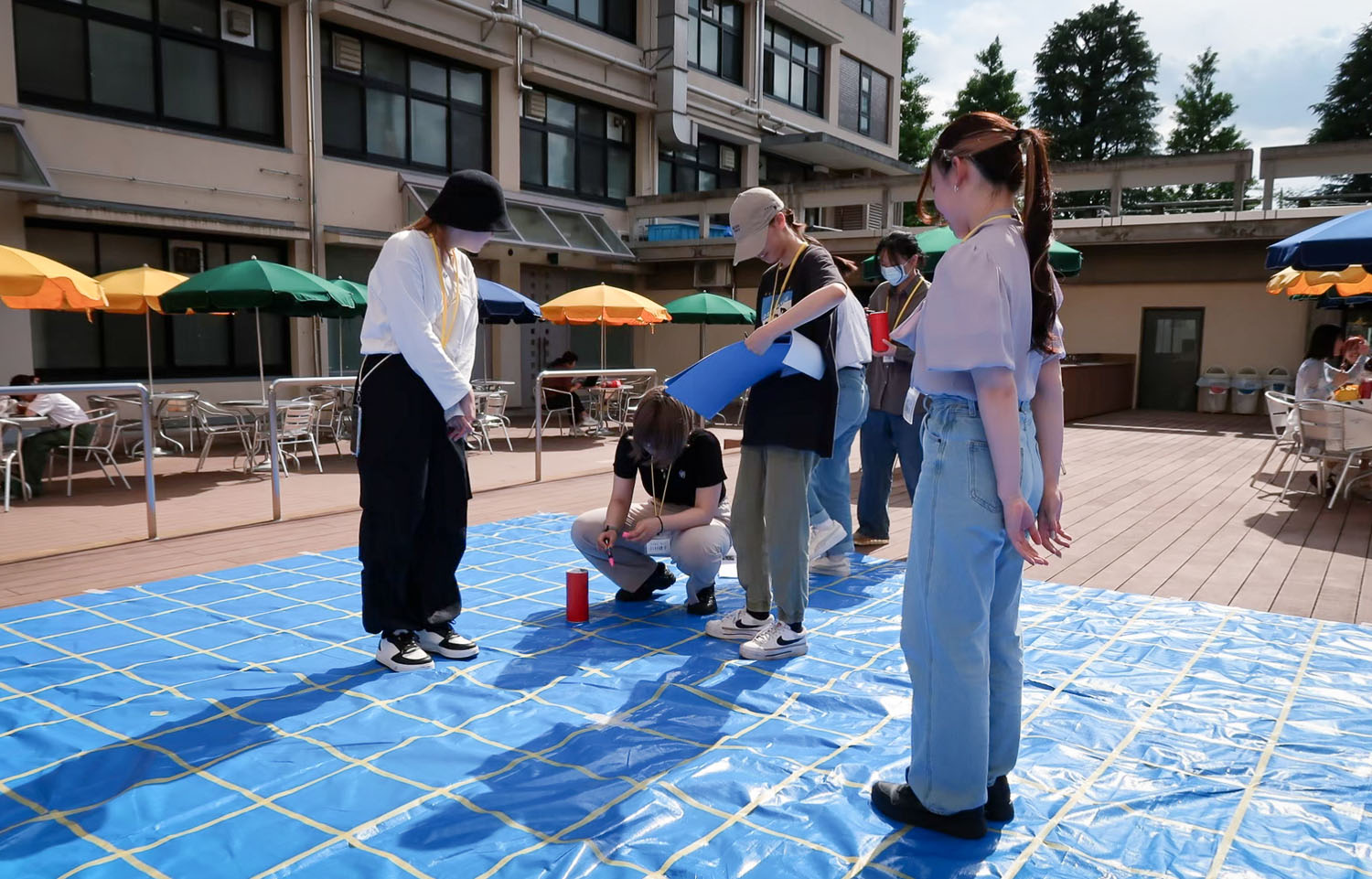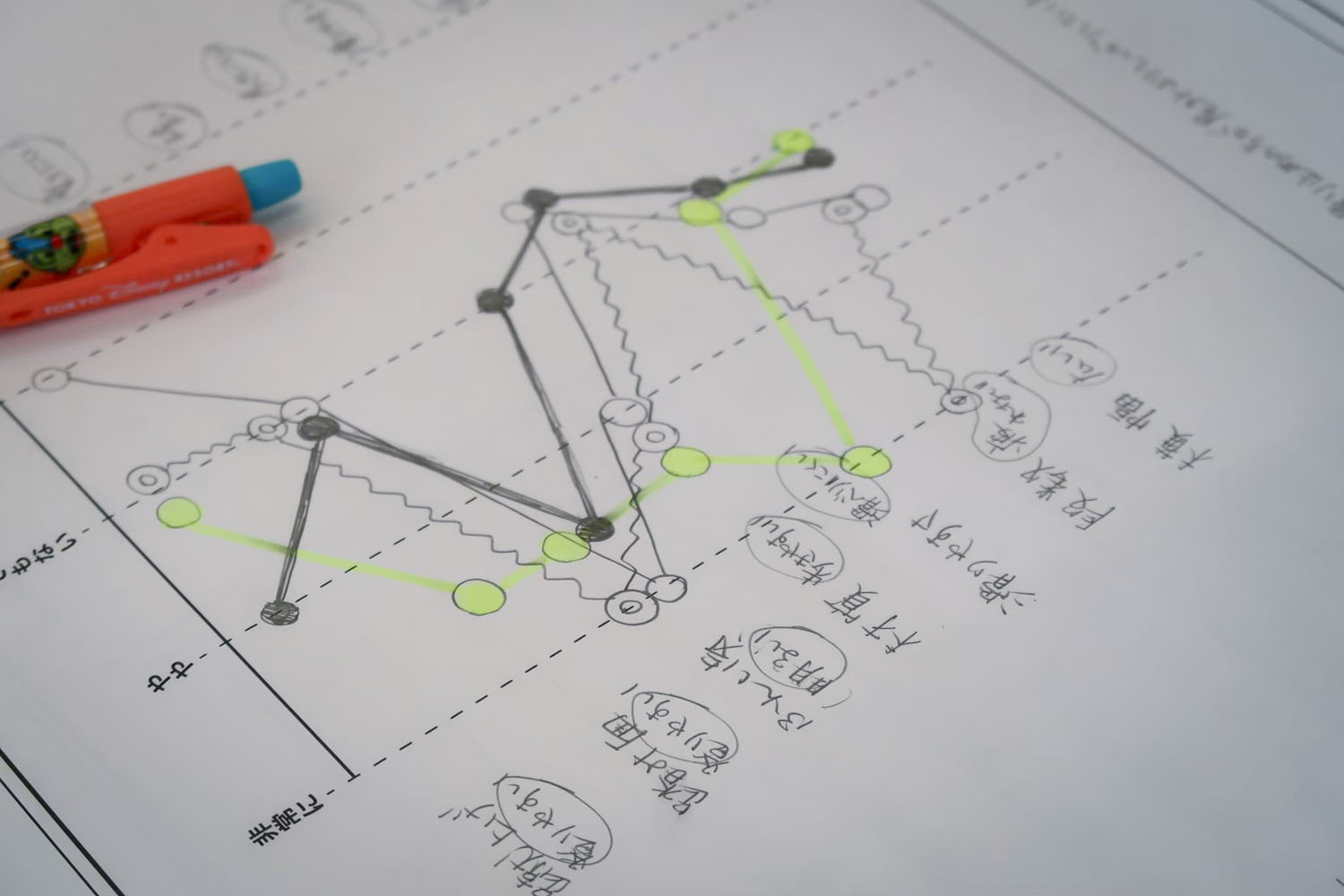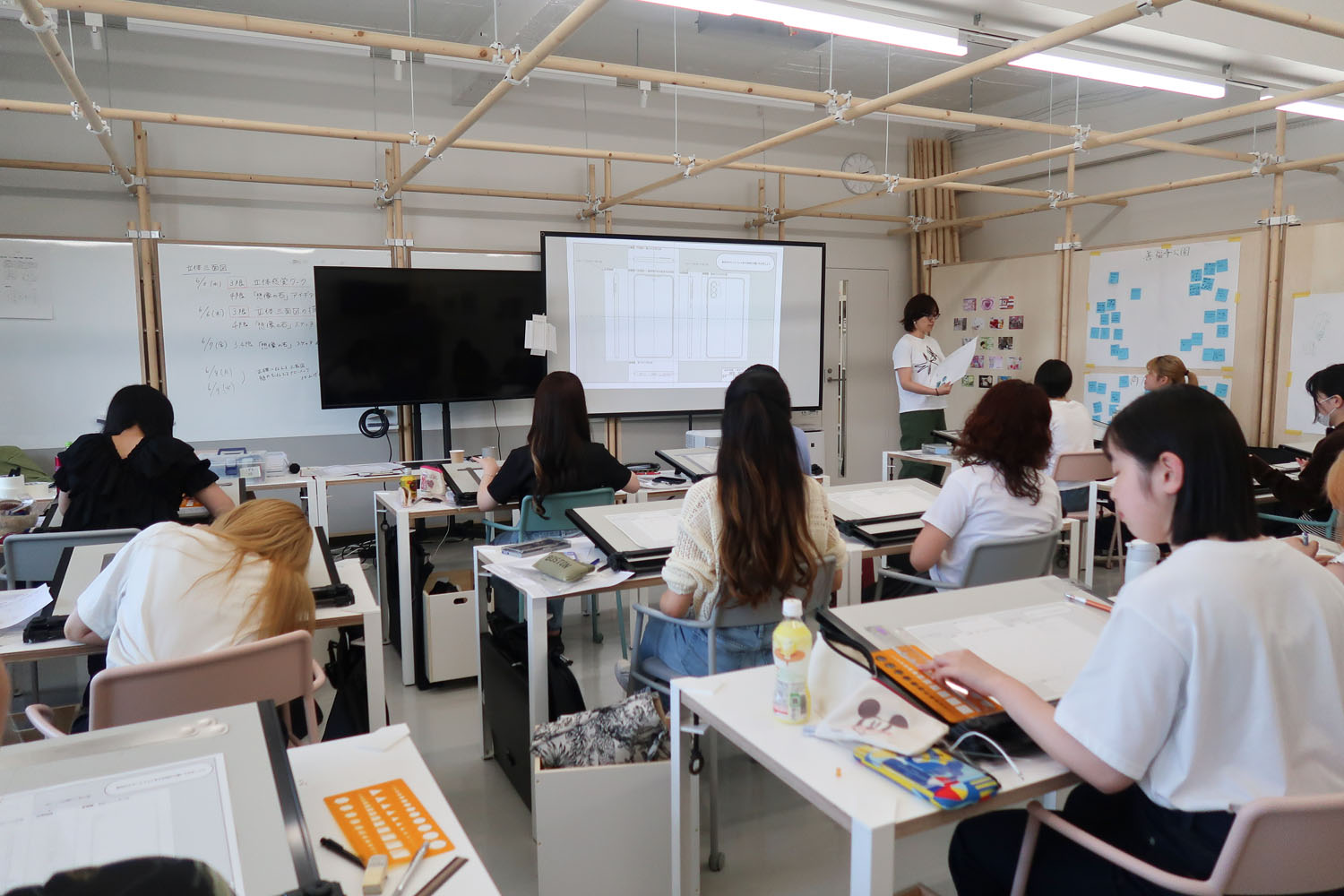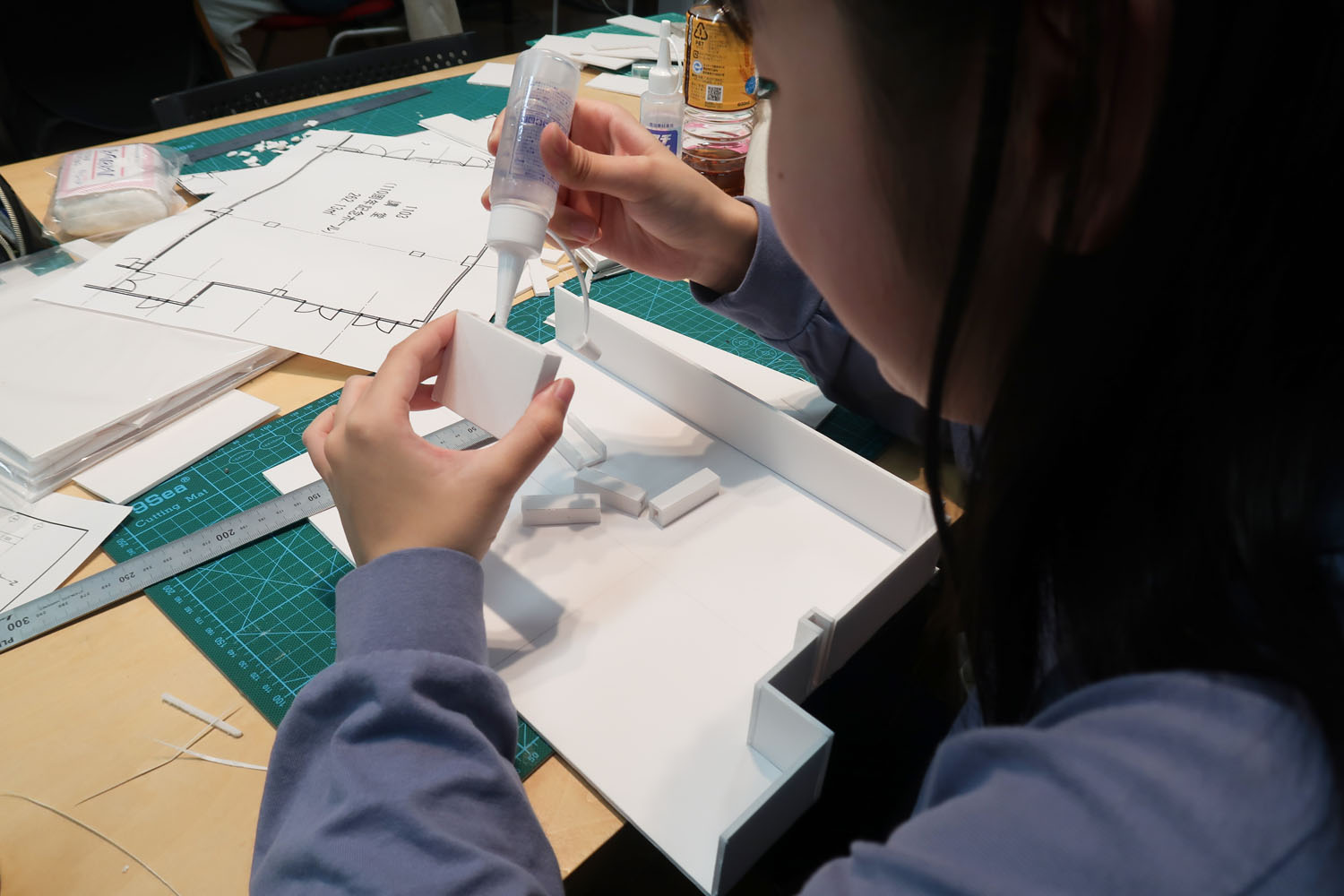Field of Art and Design for Spatial Experience
Joshibi University of Art and Design
Introduction of Subjects
We offer a variety of practical and lecture courses throughout the four years. Here we will introduce specific classes for each year.
*The information on classes for grades 3 through 4 is currently under preparation.
- 1st Year
- 2nd Year
- 3rd Year
- 4th Year
First-Year Foundations
In the first semester of the first year, students actively engage in learning the practical basics of spatial expression. This includes foundational concepts for creativity as well as hands-on techniques such as technical drawing and modeling. In the second semester, students gain an understanding of the three core concepts that form the foundation of learning in the Field of Spatial Expression through practical exercises. The program provides a supportive environment for learning from the ground up, so no prior skills in spatial expression are required upon admission.
*The subjects listed here are just a glimpse of the exciting variety of subjects available. Students can explore various other subjects that cater to their specific interests and learning goals.
Practical Subjects (Excerpts)
Spatial Creation: Foundation I (Ergonomics)
First Year / First Semester
Understanding the dimensions of the human body and the measurements necessary for daily activities is not just crucial, but also fascinating when considering and creating spaces. In this class, students learn about the dimensions associated with actions such as “walking,” “sitting,” “eating,” and “sleeping.” Additionally, the class covers various elements that impact spatial experiences, including light, sound, and smell. Students will deepen their understanding of these elements and their effects through practical exercises.
Spatial Creation: Foundation II (Drawing)
First Year / First Semester
Communicating the size and shape of a space with others is essential in creating spaces. This requires developing and interpreting drawings such as floor plans, elevations, sections, and orthographic projections for three-dimensional objects. In this class, students learn methods to represent three-dimensional spaces in two dimensions using various drawing techniques and scales. They also develop the ability to interpret these drawings and understand their spatial relationships.
Spatial Creation: Foundation III (Modeling)
First Year / First Semester
Scale models are invaluable tools for understanding and evaluating a space or a space students intend to create. Techniques for building scale models, such as “1:10” or “1:20” of the actual size, and realizing it in the real space are essential skills for anyone involved in spatial creation. In this class, students learn the techniques to accurately represent real spaces, drawings, or spatial concepts as precise scale models.
Spatial Creation: Foundation IV (Virtual Modeling)
First Year / Second Semester
In today's world, considering space often involves simulating real spaces in virtual environments and creating expressions entirely within cyberspaces like games and VR. Knowledge of digital techniques for three-dimensional modeling and spatial visualization is essential. In this class, students consider the characteristics of virtual space (non-physical space) through our own senses, as they move between real and virtual space. By looking at space from both digital and physical perspectives, we will explore the various forms of space that surround us. Also students learn to use modeling software and other tools to create and represent spaces on a computer, preparing them for the digital age of spatial expression.
Primitive Space I (Workshop)
First Year / Second Semester
This class explores “Primitive Space,” one of the three approaches to space featured by the Field of Art and Design for Spatial Experience. What does it mean to experience space? Students will explore various locations surrounding the campus to discover “Enriching space.” Through discussions, they will share their findings about what makes these spaces pleasant and the reasons behind them, thereby sharing and reflecting on each individual's “spatial experience.”
Temporary Space I (Workshop)
First Year / Second Semester
This class explores one of the three approaches to space, “Temporary Space” (Momentary Space). Students will be introduced to the concept of “scenography” (stage design), which is fundamental to performing arts. Students will express spaces that can only be experienced momentarily using performance and installation art. The class aims to engage students in expanding their perspective on comprehensive space-making that encompasses the transient nature of events as they change from one moment to the next.
Immersive Space I (Workshop)
First Year / Second Semester
This class explores “Immersive Space,” one of the three approaches to space-making. Experiencing dramatic, immersive spaces that depart from everyday life can transform even the ordinary into something vivid and extraordinary. In this class, students will learn techniques in 3D modeling and gaming to design extraordinary or secondary everyday spaces within virtual environments such as games and the metaverse.
Academic Subjects (Excerpts)
Introduction to Art and Design for Spatial Expression
First Year / First Semester
In “Introduction to Art and Design for Spatial Expression,” students delve into the three core concepts studied in the Field of Spatial Expression: Primitive Space, Temporary Space, and Immersive Space. The class begins with an overview of these concepts, followed by an in-depth exploration of each through essential case studies. Students will consider how these approaches to spatial understanding contribute to the richness of societal and individual experiences.
History of Spatial Arts
First Year / Second Semester
In “History of Spatial Arts,” students learn about various forms of art that deal with space, tracing their historical evolution. This includes “sculpture” as a representative of three-dimensional expression, “architecture” as a representative of spatial art and various genres related to human spatial experiences such as “music,” “dance,” “stage,” “film,” and “installation.” Students study these within their historical contexts and explore significant works.
Introduction to Perception and Senses
First Year / Second Semester
When people perceive their environment, various senses and images—such as vision, hearing, smell, touch, memory, thinking, and emotions—come into play. In this class, through workshops, students will deepen their understanding of these various senses and factors involved in capturing the environment. Each session will focus on a theme, allowing students to explore their senses consciously, reflect on memories, and consider perception and sensation through actual experiences.
Second-Year Foundations
Building on the foundations cultivated in the first year, students keep practically exploring three concepts that form the core of learning in the Field of Art and Design for Spatial Experience. In the first semester of the second year, students will learn spatial awareness through physical sensations, the construction of exhibition spaces, and expressive methods in film art, deepening their diverse ways of perceiving space. In the second semester, students will consider the relationship between life and space, put it into practice in public spaces, and create temporary spaces. In lectures, students will learn about materials, construction methods, and the history of lifestyles, and will comprehensively increase their knowledge and creativity. Through practice and research, students will explore and acquire their own expertise.
*The subjects listed here are just a glimpse of the exciting variety of subjects available. Students can explore various other subjects that cater to their specific interests and learning goals.
Practical Subjects (Excerpts)
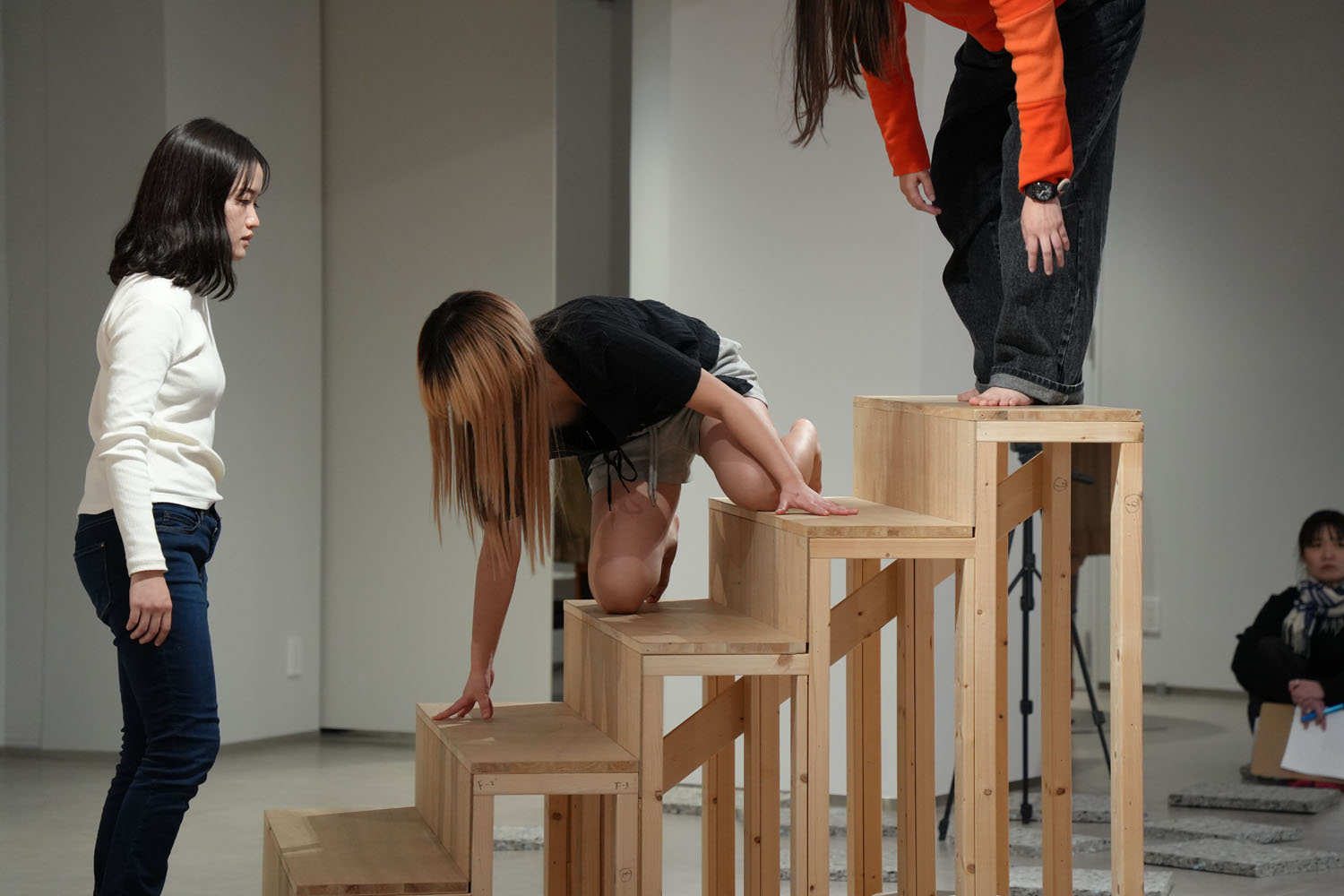
Dance performance project《place and dance the 6steps》6steps × Joshibi University of Art and Design, in collaboration between the Field of Art and Design for Spatial Experience and the Field of Creative Production and Museum Studies
Primitive Space II
Second Year / First Semester
This class focuses on our own physical sensations and reexamines "primitive space." Students explore how we perceive the "Enriching space" we found in Primitive Space I, and consider new methods of communication with the space. This class consider performance as a means of constructing and sharing space, and explore ways to share space with others based on research into physical sensations. Students will experiment with expression using objects, words, fiction, stage direction, etc., and study the elements that make up space as they shape it into each projects.

Temporary Space II
Second Year / First Semester
Following on from the fundamentals of stage sets learned in Temporary Space I, this class studies the installation of exhibition spaces. While acquiring woodworking techniques and deepening their understanding of materials, students expand their understanding of exhibition spaces based on the three axes of light environment, sound environment and materials. By actually creating the exhibition space, they externalise their learning through their bodies. By deepening their understanding of ‘showing’ in museums by dividing it into sections such as materials, tools, lighting and sound, students comprehensively develop their ability to appreciate ‘exhibition space’.

Filming of students' video works for the Regional Collaboration Project "Body language on the landscape"
Immersive Space II
Second Year / First Semester
In this class, students study what elements are involved in visualizing a world expressed in text, and explore the unique expressive methods and possibilities of film works that are shot in a limited space. Through filming, we will deeply interpret text and develop the ability to visualize it spatially. In addition, by actually shooting in the location (shooting space), students will experience how the designed space looks through the camera and screen, deepening our understanding of film art.

Primitive Space III
Second Year / Second Semester
This class explores the relationship between the act of "living" and the space. It also considers the connection between life and the locality. Based on local research, students consider the ideal form of "home" and visualize it through models, drawings, photographs, collages, etc. Eventually, they propose a temporary "home". Referring to examples of animal nests and self-built structures, students practice studies that are conscious of a sense of physical scale. Students will experientially grasp space and develop the ability to make creative proposals within realistic constraints.

KONISHI Shuka, Field of Art and Design for Spatial Experience
Temporary Space III
Second Year / Second Semester
This class explores the possibilities of enhancing the quality of the spatial experience by adding new elements to everyday places or arranging their compositions. By understanding the characteristics of public spaces and using temporary techniques, students will construct places that bring color and comfort to the people who gather there. They study the nature of space that people unconsciously seek as they pass by, and consider public spaces that give rise to serendipitous encounters and experiences. Through creative work, students will explore the quality of experiences that space brings and new possibilities for shared places.

Yokohama Stadium 2F concourse renewal (2013) / Photo: Jun Mitomi
Immersive Space III
Second Year / Second Semester
Learning about entertainment design is important as a stage for developing “Immersive spaces”. As Japanese creativity becomes internationalized and develops into a tourism value, exploring the value recognition beyond that will lead to the perspective of a spatial designer. In this class, we will study the relationship between the spread of art and space, and consider research, planning, concept creation, design, cost sense, and presentation as a series of processes. By deepening one's perspective through practice and sharing evaluations, students will gain new insights, while promoting the growth of consciousness and creative thinking.

Regional Collaboration Project "Body language on the landscape" - The Resurrection of the Great Lion Dance of Nukuri
Human Space I
Second Year / Second Semester
We will utilize the spatial concepts and methods we have worked with in the previous practices to tackle more practical projects. Students will collaborate with public facilities that are currently in operation and specific communities, proposing new spatial ideas based on the issues and themes that each location faces.
Academic Subjects (Excerpts)
Materials and Construction
Second Year / First Semester
This class acquires a wide range of knowledge about the materials and products used to create the buildings, fixtures, and public structures that make up our living space, and the methods by which they are processed and assembled. Through the lecture series, students will develop the ability to accurately select materials and construction methods appropriate to their purpose.
History of Lifestyles
Second Year / Second Semester
Humans have created diverse lifestyles while adapting to their environment and culture. Since the modern era, technological innovation and changes in social thought have significantly transformed lifestyles, forming the foundation of contemporary life. In this class, we learn about the history and culture of daily life and deepen our grounding of design through these changes. By exploring changes in the structure and values of life, students aim to grasp the essence of space and manufacturing and develop a new perspective on design.
Nonlinear Narrative
Second Year / Second Semester
In our world, countless events and pieces of information occur simultaneously. They do not exist in a single, unified line, but are intricately intertwined. In this class, we observe the countless themes and issues scattered throughout this nonlinear society and explore how stories emerge, intersect, and change in the society and culture that surrounds us. Each class will invite experts from different fields, such as law, gender, biology, etc. to touch upon various narratives that at first glance seem far removed from art and design and to consider how we, as artists or designers, can handle these stories.
Third-Year Foundations
Coming Soon
Fourth-Year Foundations
Coming Soon
Annual Schedule
| Early April | Entrance Ceremony and New Student Orientation |
|---|---|
| Mid-April | Beginning of First Semester |
| Early August to Early September | Summer Break |
| Mid-September | Beginning of Second Semester |
| Late October | Joshibi Festival |
| Late December to Early January | Winter Break |
| Late January | End of Second Semester Classes |
| Early March |
JOSHIBISION (Exhibition of Selected Works by Graduate School, University, and Junior College Students) |

Niké of Samothrace at Suginami Campus

Class Room (Suginami Campus)

School Cafeteria (Suginami Campus)

Entrance Ceremony (Suginami Campus)

Entrance Ceremony (Suginami Campus)

School Festival (Suginami Campus)

Annual School Exhibition “JOSHIBISION”
(Tokyo Metropolitan Art Museum)
Inquiries
Please visit the official website of
Joshibi University of Art and Design
for admission details and to request materials.
